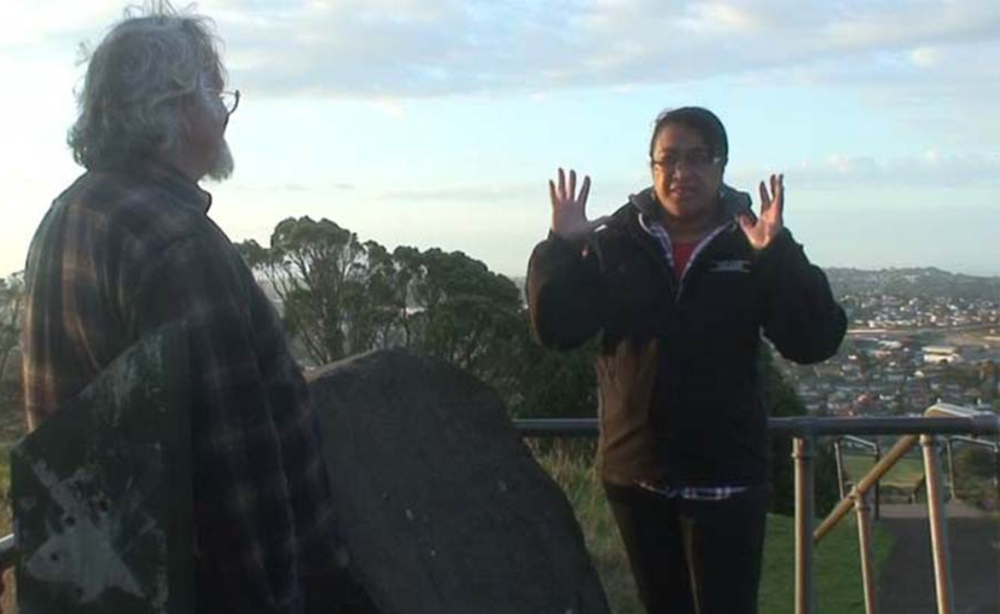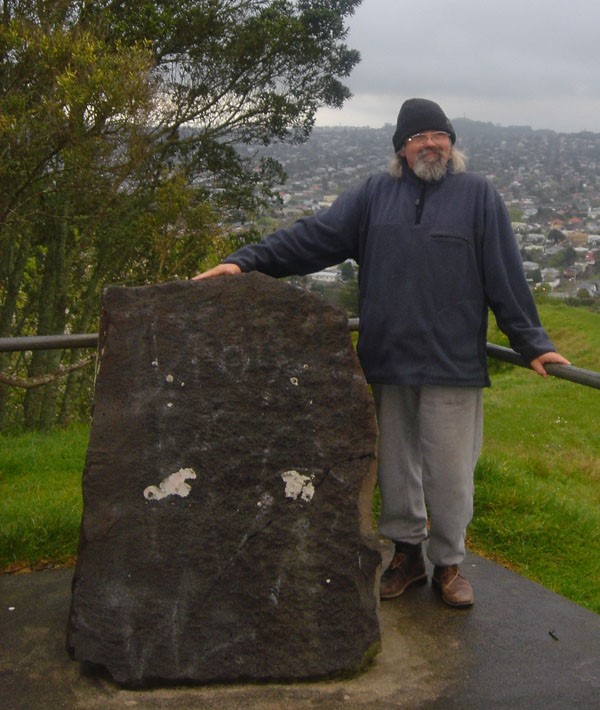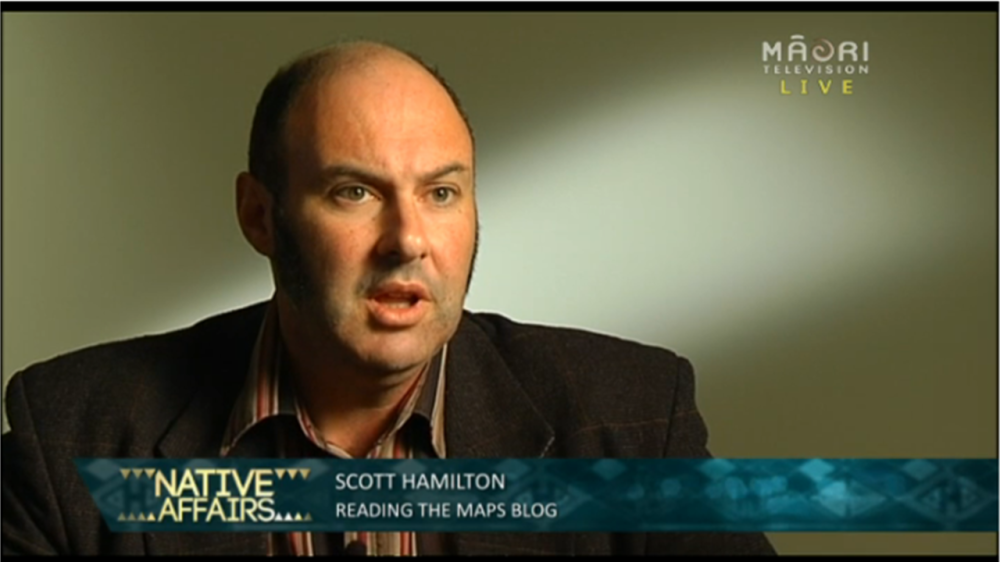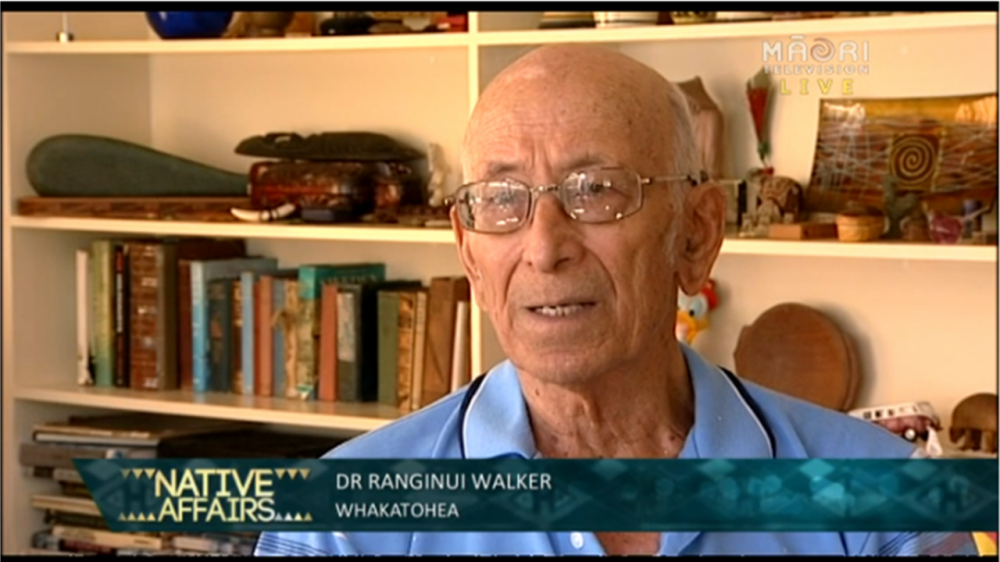Native Affairs reporter Iulia Leilua ‘framing’ Martin Doutré beside
the standing stone on Mt Albert on the morning of the autumn equinox.
Along with Mike Butler and a teacher who prefers to remain anonymous, Martin Doutré has also lodged a formal BSA complaint against Maori TV for their cynically-titled Native Affairs hatchet jobs “Tall Tales” and “What Lies Beneath”.
As expected, the channel is struggling to put together a credible response. Both Mike and the teacher have had letters from Maori TV extending their 20-working-days deadline by a further 20 working days.
(Yes, they are legally entitled to do this. And yes, it would also have been nice if they’d apologised for the delay. But apologies, it seems, are the sole prerogative of the Pakeha.)
Below is Martin’s complaint. I’ve added photos and captions.
___________________________
Date: June 6th 2014
To: Paora Maxwell
Chief Executive
Maori TV
P.O. Box 113-017
Newmarket
Auckland 1149
Attn. Vienna.Richards@maoritelevision.com
From: Martin Doutré
[address]
[phone number]
[email address]
Re: Broadcasting Standards Authority complaint about What lies beneath (screened on consecutive weeks).
Dear Sir or Madam,
On Tuesday, 4th of February 2014 I was invited to participate in a Native Affairs, Maori Television programme and to express my views on the following main topics raised by Iulia Leilua (convenor):
Martin Doutré
- Why he thinks Allan Titford is innocent
- Why he believes Te Roroa’s claim on his land was fraudulent
- How the Maori stories of Patupaiarehe and Turehu prove that Maori weren’t the first settlers of NZ
- An explanation of one of the ancient observatory sites he’s studied (Stockade Hill??)
- Why he continues his work despite heavy criticism from NZ’s leading academics
- If he’s right, what this means in terms of Maoridom’s place in NZ
- Also what it’d mean for the Treaty settlement process
- What impact Martin Doutré’s theories would have on Maori treaty claims if they were widely accepted
- Why it’s important for Maori and wider NZ to be aware of Martin’s research.
Despite my misgivings that the true intention of Native Affairs was to do a hatchet job on my work and integrity, but after receiving assurances from Iulia Leilui of fair and balanced reporting, I decided to give Maori Television the benefit of the doubt and participate.
In accordance with Iulia’s specific requests, I planned out an itinerary of archaeological sites that we would visit on the 21st of March, 2014 (the Autumn equinox), where I could demonstrate accurate equinoctial fixes on the rising and setting sun, as determined from ancient solar observatories constructed by a pre-Maori people.
Martin Doutré on Mt Albert with one of many standing stone observatories
placed on the hills around Auckland by pre-Maori people. From this spot, twice
a year only, the ancients could observe the sun rising in line with the trench they
had cut in Mt Wellington (behind) — their spring/autumn equinox marker.
To further aid Iulia in accurately reporting my views and evidence, I presented the itinerary to her in book form, complete with historical quotes related to the Patu-paiarehe people, as well as explanations and photos of archaeological sites to be visited.
The tour extended throughout an entire day, commencing before sunrise and finishing after sunset.
In the course of that long day, spanning about 14 hours of interim filming and interviews, I was agreeable to answer any and all questions that Iulia wished to ask.
I also participated at my own expense, providing all materials and gasoline for the extended tour to archaeological sites, scattered around the Auckland isthmus, at no cost whatsoever to Maori Television.
A lone piper on the Stockade Hill observatory as the sun sets in a trench
cut on Mt Wellington as an equinoctial marker. On the day we went out with
Maori TV, cloud prevented a clean shot, but the reporter had seen this photo.
Native Affairs/Maori Television later chose to misrepresent my integrity as a person, my research and views, in a clear breach of Standards 4, 5, 6 and 7 of the Broadcasting Act, 1989.
Standard 4 states:
“When discussing controversial issues of public importance in news, current affairs or factual programmes, broadcasters should make reasonable efforts, or give reasonable opportunities, to present significant points of view either in the same programme or in other programmes within the period of current interest.”
Far from airing my views in a balanced and fair manner, as promised, Native Affairs/Maori Television cherry-picked only a very selective and short segment of footage from the comprehensive interviews I provided, sufficient to show what the enemy looked like and little else.
In my stead, they substituted in lengthy diatribes from a sizable group of known adversaries, hostile to my archaeological work or documented research about the Treaty of Waitangi.
Paul Moon, and later both Scott Hamilton and Ranginui Walker, have not, to my knowledge, ever visited the archaeological sites that I demonstrated to the Native Affairs/Maori Television crew, nor do they have any known expertise related to the cultural symbolism, pictograms or known forensic attributes associated with obelisks of those sites.
The sole participation of these professional naysayers centred on unfairly debunking, without any substantiating evidence whatsoever from their quarter, my tangible, observable, scientific evidence of archaeological and historical anomalies, which were certainly worthy of serious consideration in the public arena.
These adversarial commentators instead engaged in ad hominem attacks against me personally, in lieu of any counter-evidence, inferring that I was, in fact, harbouring a hidden political agenda, hostile to Maori interests.
Their clear intention in pushing this conspiracy theory was to incite suspicion, distrust, racial hatred and derision towards me personally, thereby distracting attention away from the inconvenient scientific issues that I raised.
Far from the public having any opportunity to view my archaeological evidence and have its merits debated scientifically in an open forum, it was deliberately withheld and not shown.
In the itinerary booklet I provided for Iulia, I included many direct quotes from Maori oral traditions related to the “uru-kehu – kiri-puwhero” pre-Maori people.
These quotes have come from the learned elders of yesteryear themselves, and are copiously interspersed throughout our old history books, Native Land Court Minute Books, etc.
The many hundreds of references that issued forth from Maori oral tradition sources existed before I was born and constituted historical information available to generations of New Zealanders since the dawn of the colonial era.
Despite this, the Native Affairs programme deliberately represented this pre-Maori inhabitants’ concept as something I had conjured up out of my own imagination, as if it was some form of new, heretofore unheard of, revisionist history.
Maori activist Justin Taua went so far as to call me and others being unfairly maligned and misrepresented on the Native Affairs programme “revisionists”.
This was further substantiated by Paul Moon, who, amongst other things said, “There’s a risk of some of these strange ideas almost becoming mainstream.”
My question to each of them would be:
Why are you calling me a “revisionist” when I still believe the history I was taught as a child from our history books, or the information I gleaned directly from learned Maori elders themselves in my adolescence or latter years?
I have never changed my historical views, whereas Paul Moon and Justin Taua are, by their own words, now in denial about this aspect of our long-term, well-recorded history.
I would ask them to please explain the meaning of a couple of sample quotes, out of the hundreds I could provide from our history books.
From Tuwharetoa by Rev. John Grace, chapter 7, page 115:
“Generally speaking, Ngati Hotu were of medium height and of light colouring. In the majority of cases they had reddish hair. They were referred to as urukehu.
It is said that during the early stages of their occupation of Taupo they did not practice tattooing as later generations did, and were spoken of as te whanau a rangi (the children of heaven) because of their fair skin.
There were two distinct types. One had a kiri wherowhero or reddish skin, a round face, small eyes and thick protruding eyebrows. The other was fair-skinned, much smaller in stature, with larger and very handsome features.
The latter were the true urukehu and te whanau a rangi. In some cases not only did they have reddish hair, but also light coloured eyes.”
Hone Grace had a European father and Maori (Tuwharetoa) mother.
From The Maori Race, by Edward Tregear, pp. 562-563:
“The Maoris used to pay great respect to the bones of their dead, yet here and there may be found among sandhills, etc., human remains uncovered by the wind, and of these no tradition remains, as there would certainly be if the relics were those of ancestors.
The natives say, “These are the bones of strangers.” So also mortuary-caves are found concerning the contents of which the Maoris make the same remark, and regard them with indifference.”
Neither Paul Moon, Justin Taua or Scott Hamilton are in the least qualified to comment about my well-researched views or the tangible archaeological evidence I provided to Native Affairs/Maori Television.
By their own dismissive commentary, they are obviously ignorant concerning the oral traditions related to the Patu-paiarehe, Turehu, Pakepakeha, Ngati Hotu, Ngati Hinewai, Ngati Kura, Ngati Korakorako, Waitaha, Moriori, etc., etc., (and myriad of other named, pre-Maori groups) spoken about, seemingly, by every iwi in New Zealand.
Even Iulia Leilua, who claims Tuwharetoa lineage, appears to be ignorant or in denial of this dynamic history, as recounted by her own iwi, even though she has had direct contact with Monica Matamua who has testified to being, with evidence, of pre-Maori lineage.
If Paul Moon, Scott Hamilton, Justin Taua, Iulia Leilua or others wish to diminish the mana of the learned elders of past generations and call them liars (or worse), then they’re free to do so.
However, I would surmise that the wharewaananga-trained tohunga of past ages would consider ignorant, modern day, empty-vessel, pontificating pretenders, who knew nothing of these histories, simply as pokokohua and of no worth whatsoever, except as food.
I choose to believe the words of the learned elders of yesteryear over those of grievance-industry-aligned revisionist historians such as Paul Moon or radical Trotskyites like Scott Hamilton, etc., pushing their own political agendas.
Scraping the bottom of the barrel: Maori TV’s expert witness, Trotskyite
blogger Scott Hamilton, whose idea of civilised discourse once included
posting a photo of your host captioned “Lizard man John Ansell”.
The Native Affairs/Maori Television presentation grouped me into a batch-lot of people who were referred to as “anti-Treaty and anti-Maori”.
They wrote:
“In part one of this special report, former Northland farmer Allan Titford was portrayed in the media as a man under siege.
His supporters included people who were anti-Treaty and anti-Māori, many of whom continue to use their money, time and political connections to push their agendas.”
This accusation was reaffirmed by Mihingarangi Forbes in her introductory comments, as well as by Paul Moon, who categorised the grouped batch of individuals under attack from Maori Television as being part of a “subversive organisation” with “another agenda”.
Moon claimed that this so-called “subversive organisation”, of which I was inferred to be a part, “wanted to deny anything to do with the treaty”,etc.
This accusation is in direct breach of Standard 5 of the Broadcasting Act, 1989, which states:
“Broadcasters should make reasonable efforts to ensure that news, current affairs and factual programming:
• is accurate in relation to all material points of fact and/or
• does not mislead.”
In several interviews with Iulia Leilua, whether on the phone prior to the formal on-site interviews or during moments of casual conversation, I emphasised that I am very pro-Treaty.
I also stated that one would be hard-pressed to find three people in New Zealand who are more pro-Treaty or supportive of Te Tiriti o Waitangi than Ross Baker, Allan Titford or me.
I went to particular effort to clarify my position, as well as that of the other named individuals, but, from the very first mention on her programme of me and my work Iulia Leilua sought to misrepresent my clearly stated views.
Here are some of the dirty tricks employed in Maori Television’s attempts at character assassination:
- A sparse clip of me at an archaeological site was shown, where I had mentioned (sound-bite not broadcast) to Iulia that the intricate incising, carved bullaun bowls and chevrons in bas and raised relief on particular obelisks had been excavated from under volcanic ash from the 186 AD explosion of Taupo. The forensic evidence thus proved that these human-made features, laboriously carved into stone, predated Maori by over 1000 years.
- Rather than show the site’s component features and broadcast my explanation, Iulia immediately cut to an old archival clip of me at a Treaty-2-U protest exhibit at Rotorua in 2006 and simply stated that I:
“…dispute Maori tangata whenua status. He’s taken this message on a nationwide road show with the One New Zealand Foundation which also defends Allan Titford’s innocence.”
This is a total distortion of facts and was designed to mislead.
I wrote a comprehensive, fully documented book on the subject matter of the Treaty of Waitangi in 2005, which Iulia purports to have read, and my 2006-2007 tour around New Zealand on the heels of the Treaty-2-U propaganda road-show was to protest against the historical lies being told by The Treaty of Waitangi Information Unit.
Our small protest group provided documented proof that Treaty-2-U was totally misrepresenting the true intent, purpose and meaning of the treaty in their indoctrination of forcibly bused-in, captive-audience, schoolchildren.
My participation had nothing whatsoever to do with “Maori tangata whenua status” and was solely focused on treaty text accuracy and interpretation.
See: http://www.treatyofwaitangi.net.nz/Treaty2UPart1.htm
Iulia in her commentary states:
“They also promote an alternative version of the Treaty called the Littlewood Treaty discovered in Pukekohe in 1989. It’s been used to dispute Maori land rights and the treaty signed in 1840.”
This again is a total distortion of the facts I relayed to Iulia, and runs counter to what I clearly stated in my 2005 book about the Treaty.
None of us have ever claimed that the Littlewood document is a “treaty” or “alternative version of the treaty”.
On the contrary, we have always emphasised that it is merely the final English draft from which Te Tiriti o Waitangi (in the Maori language) was translated.
The term “Littlewood Treaty” was probably first coined in 1992 by Claudia Orange and known by that title within a close-knit academic circle.
We have merely raised a very legitimate and scholarly argument that no mainstream historian has been able to counter with documented proof.
Even Paul Moon, who is outwardly antagonistic and scathing towards those of us showing evidence the Littlewood document is the final English draft (handwritten by Busby), can’t come up with anything to counter its authenticity.
On the contrary, he’s on public record as saying the following:
- “I agree that the Littlewood document is dated 4 February 1840, and that there was almost certainly no subsequent drafting of the Treaty’s English text’ (From Dr Paul Moon’s 30/8/04 letter to treaty researcher Ross Baker, and posted onto the ONZF website.)
- “On 30th March, US Commodore Charles Wilkes, Antarctic explorer, arrived in the Vincennes to join his other ships Porpoise and Flying Fish. Damaged after their bruising exploration of the icy land, they reprovisioned and repaired their ships till late April. As he left Clendon gave him a further despatch containing a hand-written copy of the Treaty in English copied from Busby’s copy of the final draft. It is believed that Clendon then retained Busby’s copy of the Treaty” (The Treaty and Its Times, by Paul Moon and Peter Biggs, ch. 9, p. 213).
In your role as an ever-on-call expert witness about almost everything and everyone, please explain Paul!
As Paul Moon must know, for the Littlewood document to qualify as the final English draft and mother document to Te Tiriti o Waitangi (the English draft, known by our Treaty historians to have gone missing in about February 1840), it must comply to the following forensic criteria:
- It had to be on paper that preceded the signing of the treaty in 1840 and that paper had to be identifiable as stock in use at the Bay of Islands in February 1840. If the paper was from an orphan stock, then that would cast doubt upon the authenticity of the document.
Clendon’s W. Tucker 1833 watermarked stock fulfils this requirement.
- The paper had to have a pedigree traceable back to one of the founding fathers who drafted the treaty and, ultimately to Busby and Hobson.
The Littlewood document’s pedigree is impeccable and fully traceable to Clendon, Busby and Hobson himself.
- The author of the hand-written text had to be James Busby, British Resident.
That attribute of the Littlewood document is also beyond dispute.
- It had to bear the date, the 4th of February 1840, as that’s the day the final English draft was written.
It is clearly signed off, 4th Feb 1840.
Despite our exhaustive efforts to be very clear on our position, grievance-industry historians like Paul Moon continuously try to detour public thinking away from the true status of the document with such well-worn, red-herring banalities as:
“It can’t be a treaty ’cause it’s not signed.”
Well, of course it’s not signed, Paul – it’s only a draft!
Now Iulia is resorting to the same dirty tricks in deliberately misreporting and misrepresenting what I have expended great effort to explain clearly to her.
She has video footage of me explaining that there “is only one treaty and it’s in the Maori language”.
She also has video footage of me corroborating that statement with a historical quote from Lieutenant-Governor William Hobson, where he said the following about the Maori language document signed at Waitangi on the 6th of February 1840:
“The treaty, which forms the base of all my proceedings was signed at Waitangi, on the 6th February, 1840, by 52 chiefs, 26 of whom were of the Confederation, and formed a majority of those who signed the Declaration of Independence. ‘This instrument I consider to be de facto the treaty, and all signatures that are subsequently obtained are merely testimonials of adherence to the terms of the original document.”
(Letter to Major Bunbury, The Treaty of Waitangi, by T.L. Buick, p. 162.)
I expressed to Iulia my view that there is no English Treaty, only the final English draft from which Te Tiriti o Waitangi was translated. It has no status as a treaty and neither does anything else in English.
I stated that the lost, final English draft was definitely found again in Pukekohe in 1989 and in my book, which Iulia had in her possession, I mention three other exemplars of the final English draft wording that have languished in overseas archives since February-April 1840 (four in total known to exist in early 1840).
Iulia knows full-well that our only gripe stems from the utter reinvention of the Treaty’s meaning since 1975, after a very defective ENGLISH text was introduced to sit alongside Te Tiriti o Waitangi and be co-equal to it.
The terrible text chosen was one of James Stuart Freeman’s seven variable Formal Royal Style English versions, which were all based upon early rough draft notes and not the final English draft.
Because of the vast differences in wording between that English version and Te Tiriti o Waitangi in Maori, after 1975 the treaty meaning got deliberately reinterpreted (reinvented) until it bore no resemblance whatsoever to what was so clearly stated in either Te Tiriti or the final English draft.
Iulia has video footage of me describing Te Tiriti as a very welcome, benign “gift” from the chiefs in 1840, so, in reference to my clearly stated position and my clear evidence to the contrary, why did Native Affairs/Maori TV mischievously represent me as “anti-Treaty”?
This constitutes a very deliberate slur against my well-described and publicised views and shows that Native Affairs/Maori TV are utterly incapable of accurate investigative reporting.
The Littlewood document subject matter was very worthy of comprehensive discussion in the public arena.
Despite my giving Maori TV an entire day of time and answering any question they wished to pose, the on-archaeological-sites environment in which I conducted the interviews was, obviously, not to their liking.
They obviously wanted me in their sterile studio, being yelled down by ranting adversaries, where I could not display, first-hand, my archaeological evidence.
Even though I had already answered all their questions on camera, Mihingarangi Forbes announced to her viewing audience that I had refused to appear.
Why did I need to appear twice when they had not yet used the lengthy interviews from my first appearance?
It is my firm belief that Native Affairs are deliberately engaging in ad hominem attacks and smear-campaigns in order push their brand of self-serving propaganda.
They wish to promote only that which is beneficial to their own political agenda and have no genuine interest whatsoever towards anything considered counter-productive to their prescribed goals.
Moreover, Annette Sykes displayed an utter lack of knowledge, or worse, related to the origin and significance of the “Littlewood document”.
However, she can correct her misconceptions by studying the entire paper trail and pedigree of the document at: http://www.celticnz.org/TreatyBook/Precis.htm
Dirty tricks employed by Native Affairs further include:
GUILT BY ASSOCIATION
Although political scientist and historian Kerry Bolton, has not, to my certain knowledge, been in any way associated with the marital dispute involving Allan Titford, every effort was made to link him into a confederation with those supporting a retrial for Titford.
No such confederation exists and we pursue totally separate lines of research. His books and scholarly treatises on Marxism or other historical issues are much respected and published in academic journals around the world.
Although Ngati-Hotu kuia Monica Matamua has a dynamic story to tell about her links back to Patu-paiarehe ancestors, supported by DNA evidence and whakapapa, her claim was deliberately rendered suspect by a deceptive ruse of linking her to such dastardly fellows as Martin Doutré, Mykeljon Winckel of Elocal magazine and Kerry Bolton.
This was a treacherous, red-herring tactic employed to discredit a very dignified kuia, whose family has fought for generations to have their unique lineage and tribe recognised.
Her evidence is stand-alone and does not depend upon what Martin Doutré or anyone else “thinks”.
From my perspective, I feel that Iulia Leilua played both ends against the middle in order to get Monica Matamua to participate on the Native Affairs/Maori TV programme.
Iulia emailed me on 14/2/14 and stated:
“Kia ora Martin, just wondering if you could help me organise an interview with Monica Mataamua about her DNA testing?”
I gave Iulia the contact details that I had and, much later, after the terrible programme aired, Monica wrote the following:
“I have gone over and over Iulia’s native affairs program on the internet and the more I studied it the more crooked it got.
I must say she hounded me for months as I am wary of why people want to see me.
I only agreed after Marty [Martin Doutré] said he had done an extensive documentary for them so when she did turn up I thought it would be a special edition on N Hotu.
Instead she used my story, cut and spliced it to fit into her dirty scheme of hatred, prejudice and racism. Had nothing to do with the truth’”. etc.
Monica Matamua was seemingly lured into participation largely on a pretext proffered by Iulia that I would provide visual evidence of Patu-paiarehe structures.
Monica correctly saw that a very dynamic documentary was possible, which could be composed of visual evidence of ancient astronomical and surveying structures, coupled with oral history testimony, DNA evidence and whakapapa.
Such a documentary would, undoubtedly, go a long way towards opening up a floodgate of testimony from the old learned elders, whose knowledge has been muted and supressed for many years now.
Huge new insights into our long-term history would, most certainly, result.
However, such a positive outcome obviously ran counter to the political agenda of Native Affairs.
Monica was simply used in a fashion that would diminish and trivialise her claim to pre-Maori heritage and even make a mockery of it by associating any such claim with discredited nutters and antagonists like Martin Doutré, or a gaggle of other fringe-dwellers stigmatised by the Native Affairs inquisitors.
So, it seems that tribalism, with its tradition of conquerors holding all the mana and the vanquished having none, won the day in the eyes of the unsuspecting viewing public.
The outcome was that Iulia’s Tuwharetoa tribe got to marginalise, hold at bay, and silence Monica’s Ngati Hotu tribal claim yet again by use of red-herring distractions and editing strategies.
Native Affairs are in breach of standards 4, 5 & 6 in relation to their disrespectful treatment of kuia Monica Matamua.
LOGICAL FALLACIES
They have deliberately tried to mislead their audience and unfairly instil doubt about Monica’s assertion by using a logical fallacy along the lines of:
- Monica Matamua believes she is of Patu-paiarehe lineage.
- Martin Doutré believes Monica is of Patu-paiarehe lineage, but is a disreputable fellow who tells lies.
- Monica Matamua is, therefore, not of Patu-paiarehe lineage.
This perverted form of logic, geared to unfairly manipulate the thinking of the viewers who fund Native Affairs/Maori TV from the public purse, was also used discredit the many years of documented, historical research undertaken by Allan and Susan Titford, Ross Baker and others into the Te Roroa land claim.
With regards to Titford, one of the several logical fallacies employed by Native Affairs to discredit his documented research was along the lines of:
- Te Roroa claim a right to own part or all of Allan Titford’s farm at Maunganui Bluff and seek historical redress.
- Allan Titford is a disreputable fellow who burnt down his own farmhouse.
- Te Roroa’s historical claim is therefore correct, their redress is justified and Titford’s documented research is wrong.
Several other usages of the same kind of logical fallacy could be cited in the very obvious smear campaign mounted by Native Affairs against Allan Titford and his supporters.
ALLEGATIONS AGAINST ALLAN TITFORD
With regards to Maori TVs accusation that “Allan Titford burnt down his own house”, I witnessed John Ansell handing Iulia Leilua two affidavits that testified to the fact that Graham Neville Cochrane, Susan Titford’s father, had committed the arson and had made a death-bed confession of having done so.
One of these affidavits had been sworn before the Police Declarations Officer and the other before a Notary Public.
John Ansell had chosen Maori TV as the media outlet for a public launch of this very special information and we have video footage of Iulia both receiving the affidavits and having their significance explained to her by Ansell.
Despite this, Maori TV’s later assault on Allan Titford relied heavily on the false premise that he was the arsonist.
The core issue or foundation upon which their case against Titford was built was how he was guilty of this nefarious act, but how he’d deceptively blamed Te Roroa for it.
Moreover, Ranginui Walker showed himself to be deliberately obtuse and uninformed regarding the final payout to Allan Titford.
With minimal research, Walker would have ascertained that Titford received a very paltry sum when he was forced, under duress and threats, to forfeit his 1746 acre farm.
Gramsci’s foot soldier: Ranginui Walker, Lebanese Maori sovereigntist and
acolyte of Italian communist Anton Gramsci, who predicted in the 1920s that
“socialism will triumph by first capturing the culture — by infiltration of the
schools, universities, churches and the media”. (Ditto Treatifarianism.)
Walker’s facts and figures smacked of pure propaganda and he came across as a hateful racist who holds “pakeha” in utter contempt.
It’s of significance also that, whereas so-called “pakeha” can be demonised or ridiculed with impunity, under the protocols of Native Affairs tribalism individuals like Alex Nathan of Te Roroa are portrayed in more saintly fashion, beyond reproach or criticism.
In the interests of what Iulia Leilua describes as “balance”, perhaps Native Affairs could do an exposé on Nathan’s stewardship over the Te Roroa rank and file funds and efforts to recover the missing millions of dollars that disappeared during Alex Nathan’s watch as chairman.
SUMMARY
Native Affairs/Maori TV have shown themselves to have a solitary allegiance to Maori grievance-industry agendas, to the exclusion of all else.
Their condescension, unashamed manipulation and insult-to-the-intelligence of their viewing audience, in only telling the viewer what they need to know, is despicable and falls far short of ethical responsibility.
There is no provision of fair, unbiased and balanced reporting, where the viewers are empowered to consider all of the facts for themselves and come to an informed, coherent conclusion of their own volition and free will.
Maori TV, within the confines of “What Lies Beneath” (all segments) coerced its audience into accepting points of view acceptable to Native Affairs.
Other points of view were not presented with sufficient clarity that one could draw any conclusions about their merit.
All in all, Native Affairs led viewers by the nose to a singular, premeditated conclusion, by providing no valid alternative avenues for consideration, after having done a hatchet job on anyone harbouring a contrary point of view, or proffering significant counter-information.
CONCLUSION
Native Affairs/Maori TV is a blatantly racist, political organ in support of Maori supremacy and the grievance industry.
It offers nothing of educational value that would be of interest to the majority of New Zealanders and, as a special interest group’s propaganda outlet, should not be funded by the taxpayer.
Martin Doutré














